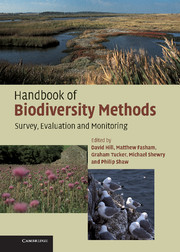Book contents
- Frontmatter
- Contents
- Preface
- Acknowledgements
- Part I Planning
- Part II Habitats
- Part III Species
- 9 Introduction to species assessment
- 10 General principles and methods for species
- 11 Fungi
- 12 Lichens
- 13 Bryophytes
- 14 Aquatic macrophytes and algae
- 15 Vascular plants
- 16 Dragonflies and damselflies
- 17 Butterflies
- 18 Moths
- 19 Other terrestrial invertebrates
- 20 Aquatic invertebrates
- 21 Fish
- 22 Amphibians
- 23 Reptiles
- 24 Birds
- 25 Bats
- 26 Other mammals
- Appendix 1 Monitoring and reporting obligations under international conservation agreements
- Appendix 2 Relationship between BAP Priority Habitat and Broad Habitat categories and Habitats Directive nomenclature
- Appendix 3 Annotated list of key references for plant identification
- Appendix 4 Determining appropriate quadrat size for vegetation sampling
- Appendix 5 The relocation of permanent plots
- Appendix 6 Equipment required for undertaking different types of survey
- Recommended sources of further information
- References
- Glossary
- Index
23 - Reptiles
Published online by Cambridge University Press: 01 September 2010
- Frontmatter
- Contents
- Preface
- Acknowledgements
- Part I Planning
- Part II Habitats
- Part III Species
- 9 Introduction to species assessment
- 10 General principles and methods for species
- 11 Fungi
- 12 Lichens
- 13 Bryophytes
- 14 Aquatic macrophytes and algae
- 15 Vascular plants
- 16 Dragonflies and damselflies
- 17 Butterflies
- 18 Moths
- 19 Other terrestrial invertebrates
- 20 Aquatic invertebrates
- 21 Fish
- 22 Amphibians
- 23 Reptiles
- 24 Birds
- 25 Bats
- 26 Other mammals
- Appendix 1 Monitoring and reporting obligations under international conservation agreements
- Appendix 2 Relationship between BAP Priority Habitat and Broad Habitat categories and Habitats Directive nomenclature
- Appendix 3 Annotated list of key references for plant identification
- Appendix 4 Determining appropriate quadrat size for vegetation sampling
- Appendix 5 The relocation of permanent plots
- Appendix 6 Equipment required for undertaking different types of survey
- Recommended sources of further information
- References
- Glossary
- Index
Summary
Reptile surveying and monitoring can be problematic; reptiles are active, shy creatures, which do not aggregate for breeding as do amphibians. Their behaviour is also heavily influenced by the weather. Most methods for surveying and monitoring reptiles do not generally produce sufficient data to enable population size to be estimated, unless mark–recapture techniques are used.
ATTRIBUTES FOR ASSESSING CONDITION
Population size
Estimates of population size for reptiles are made during April–October. Most methods for estimating total population size employ mark–recapture studies. Population indices can be obtained without mark–recapture work, but results are less accurate.
Breeding success
Whether or not reptiles are breeding successfully can generally only be ascertained by counting the number of young animals entering the breeding population each year.
Survival and mortality
Estimates of survival and mortality can only reliably be made by mark–recapture studies; the survival of individually marked animals from one trapping occasion to the next can be estimated. Unless dead animals are found, it is not usually possible to distinguish between mortality and emigration. Similarly, immigration and births can be easily confused, unless you are certain that the population is isolated.
GENERAL METHODS
A survey for reptiles should start with an assessment of the habitat suitability for different species, to establish which, if any, reptiles are likely to occur in the area. For example, Grass Snakes Natrix natrix are more likely to occur in areas with freshwater bodies; a summary of the habitat requirements of the different species can be found in Gent & Gibson (1998).
- Type
- Chapter
- Information
- Handbook of Biodiversity MethodsSurvey, Evaluation and Monitoring, pp. 404 - 411Publisher: Cambridge University PressPrint publication year: 2005



